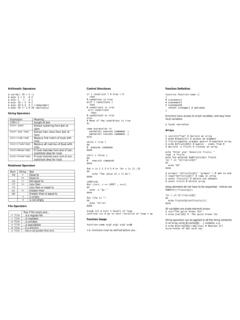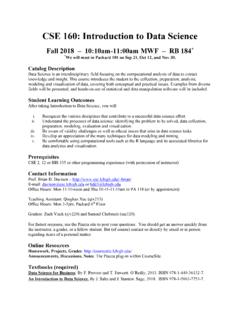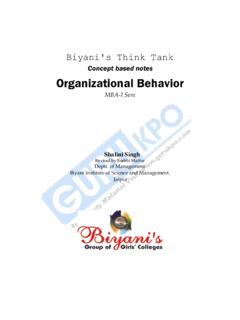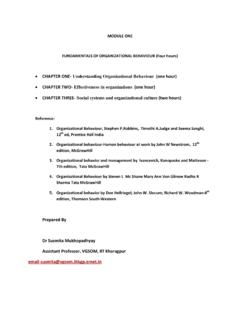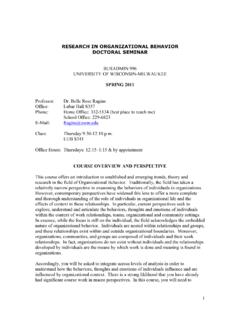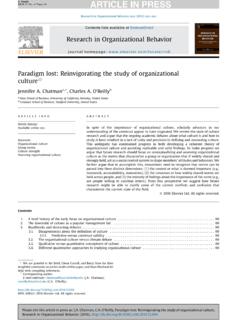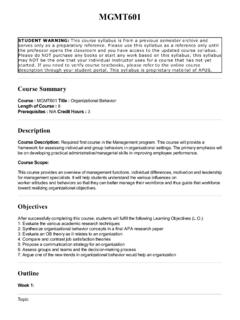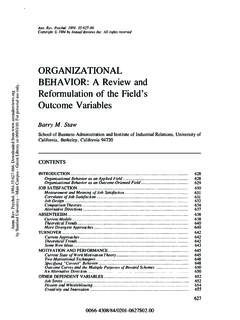Transcription of Organizational Behavior and Organizational Change ...
1 CSE & Enterprise Systems CenterLehigh University1 Roger N. Nagel 2006 Organizational Behavior andOrganizational ChangeLeadership & Power Roger N. NagelSenior Fellow & Wagner ProfessorLehigh UniversityCSE & Enterprise Systems CenterLehigh University2 Roger N. Nagel 2006 Topics This Presentation What Is Leadership? Leadership Traits Grid Management Styles Path-Goal Theory of Leadership Trust: The Foundation of Leadership Dimensions of Trust Three Types of Trust Basic Principles of Trust Charismatic approaches to leadership Key Characteristics of Charismatic Leaders Beyond Charismatic Leadership Contemporary Leadership Roles Mentoring Ethical Leadership Facilitating Leader Organizational Behavior Eleventh EditionBy Steve RobbinsISBN 0-13-191435-9 Reference Book Organizational Behavior Eleventh EditionBy Steve RobbinsISBN 0-13-191435-9 Reference Book2o r g a n i z a t i o n a l b e h a v i o ro r g a n i z a t i o n a l b e h a v i o rstephen p.
2 Robbinse l e v e n t h e d i t i o ne l e v e n t h e d i t i o nCSE & Enterprise Systems CenterLehigh University3 Roger N. Nagel 2006 Topics This Presentation Personal Power A Definition of Power Contrasting Leadership and Power Bases of Power: Formal Power Information Power Personal Power Dependency Power Power Tactics Power in Groups Power & Politics Defensive Behaviors Blame Culture in an Organization Organizational Behavior Eleventh EditionBy Steve RobbinsISBN 0-13-191435-9 Reference Book Organizational Behavior Eleventh EditionBy Steve RobbinsISBN 0-13-191435-9 Reference Book2o r g a n i z a t i o n a l b e h a v i o ro r g a n i z a t i o n a l b e h a v i o rstephen p.
3 Robbinse l e v e n t h e d i t i o ne l e v e n t h e d i t i o nCSE & Enterprise Systems CenterLehigh University4 Roger N. Nagel 2006 What Is Leadership?LeadershipThe ability to influence a group toward the achievement of of authority inherent in designated formal rank to obtain compliance from Organizational 332 Page 332 CSE & Enterprise Systems CenterLehigh University5 Roger N. Nagel 2006 Leadership Traits: USA ViewLeadership Traits: Ambition and energy The desire to lead Honest and integrity Self-confidence Intelligence High self-monitoring Job-relevant knowledgeLeadership TraitsLeadership Traits:: Ambition and energyAmbition and energy The desire to leadThe desire to lead Honest and integrityHonest and integrity SelfSelf--confidenceconfidence IntelligenceIntelligence High selfHigh self--monitoringmonitoring JobJob--relevant knowledgerelevant knowledgeCSE & Enterprise Systems CenterLehigh University6 Roger N.
4 Nagel 2006 Behavioral Theories Trait theory:Leaders are born, not made. Behavioral theory:Leadership traits can be taught. Trait theory:Trait theory:Leaders are born, not are born, not made. Behavioral theory:Behavioral theory:Leadership traits can be traits can be Theories of LeadershipTheories proposing that specific behaviors differentiate leaders from ViewMy ViewAgreeDisagreeCSE & Enterprise Systems CenterLehigh University7 Roger N. Nagel 2006 Grid Management StylesEmployee-Oriented LeaderEmphasizing interpersonal relations; taking a personal interest in the needs of employees and accepting individual differences among LeaderOne who emphasizes technical or task aspects of the & Enterprise Systems CenterLehigh University8 Roger N.
5 Nagel 2006 The Managerial Grid(Blake and Mouton)E X H I B I T 11 1 Page 337E X H I B I T 11 1 Page 337 CSE & Enterprise Systems CenterLehigh University9 Roger N. Nagel 2006 Scandinavian StudiesDevelopment-Oriented LeaderOne who values experimentation, seeking new ideas, and generating and implementing in Finland and Sweden question whether there are only two dimensions (production-orientation and employee-orientation) that capture the essence of leadership Behavior . Their premise is that in a changing world, effective leaders would exhibit development-oriented Behavior . CSE & Enterprise Systems CenterLehigh University10 Roger N.
6 Nagel 2006 Path-Goal Theory of LeadersshipPath-Goal TheoryThe theory that it is the leader s job to assist followers in attaining their goals and to provide them the necessary direction and/or support to ensure that their goals are compatible with the overall objectives of the group or 344 Page 344 CSE & Enterprise Systems CenterLehigh University11 Roger N. Nagel 2006 Trust: The Foundation of LeadershipTrustA positive expectationthat another will not through words, actions, or decisions act is a history-dependent process (familiarity) based on relevant but limited samples of experience (risk).E X H I B I T 12 1 Page 356E X H I B I T 12 1 Page 356 CSE & Enterprise Systems CenterLehigh University12 Roger N.
7 Nagel 2006 Dimensions of Trust Integrity honesty and truthfulness. Competence technical and interpersonal knowledge and skills. Consistency reliability, predictability, and good judgment in handling situations. Loyalty the willingness to protect and save face for another person. Openness reliance on the person to give you the full & Enterprise Systems CenterLehigh University13 Roger N. Nagel 2006 Trust and LeadershipLeadershipLeadershipLeadership TRUSTandINTEGRITYTRUSTTRUST andandINTEGRITYINTEGRITYCSE & Enterprise Systems CenterLehigh University14 Roger N. Nagel 2006 Employees Trust in Their CEOsEmployees who believe in senior management:Source: Gantz Wiley Research.
8 Reproduced in USA Today, February 12, 2003, p. X H I B I T 12 2 Page 358E X H I B I T 12 2 Page 358 CSE & Enterprise Systems CenterLehigh University15 Roger N. Nagel 2006 Three Types of TrustDeterrence-based TrustTrust based on fear of reprisal if the trust is TrustTrust based on a mutual understanding of each other s intentions and appreciation of the other s wants and TrustTrust based on behavioral predictability that comes from a history of & Enterprise Systems CenterLehigh University16 Roger N. Nagel 2006 Basic Principles of Trust Mistrust drives out trust. Trust begets trust. Growth often masks mistrust.
9 Trust increases cohesion. Mistrusting groups self-destruct. Mistrust generally reduces are the important leadership traits from your point of view? Please add any traits you feel are missing!Willing to SacrificeVisionaryCharismaticTrust BuildingPath-GoalDevelopment-OrientedJob -relevant knowledgeHigh self-monitoringIntelligenceSelf-confiden ceHonest and integrityThe desire to leadAmbition and energyChinese ViewChinese ViewLeadership TraitsLeadership TraitsUSA ViewUSA ViewCSE & Enterprise Systems CenterLehigh University18 Roger N. Nagel 2006 Charismatic Approaches to LeadershipCharismatics Influence Followers By:1.
10 Articulating the vision2. Setting high performance expectations3. Conveying a new set of values4. Making personal sacrificesCharismatics Influence Followers By:1. Articulating the vision2. Setting high performance expectations3. Conveying a new set of values4. Making personal sacrificesCharismatic Leadership TheoryFollowers make attributions of heroic or extraordinary leadership abilities when they observe certain & Enterprise Systems CenterLehigh University19 Roger N. Nagel 2006 Key Characteristics of Charismatic LeadersE X H I B I T 12 3 Page 363E X H I B I T 12 3 Page 3631. Vision and a vision expressed as an idealized goal that proposes a future better than the status quo; and is able to clarify the importance of the vision in terms that are understandable to Personal to take on high personal risk, incur high costs and engage in self-sacrifice to achieve the Environmental to make realistic assessments of the environmental constraints and resources needed to bring about Sensitivity to follower of others abilities and responsive to their needs and Unconventional in behaviors that are perceived as novel and counter to : Based on J.



